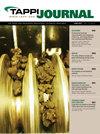Research needs for nanocellulose commercialization and applications
IF 0.6
4区 农林科学
Q4 MATERIALS SCIENCE, PAPER & WOOD
引用次数: 5
Abstract
This short review deals with some applications and research needs for nanocellulosic (NC) materials; primarily cellulose nanocrystals (CNC), cellulose nanofibers (CNF), and bacterial cellulose (BC). Whereas CNC and BC materials are fairly homogenous, CNF materials represent a wide sector of different materials, often with a high heterogeneity. This is due to different pretreatment methods (mechanical, chemical, enzymatic), woodbased or agricultural-based materials, delignification and bleaching procedures, etc. The purpose of this comprehensive review is not to discuss the various production methods, for which the reader may consult with a selected number of reviews [1-6]; thus, the focus is on practical applications. Practical applications and potential markets were also discussed some years ago by other investigators [7-8]. Upscaling and choice of pretreatment methods, as well as economic considerations and different business models, have also been discussed, along with: • Toxicity and environmental issues [9-10] • The complex characterization of cellulose nanomaterials [4] The reader should also be aware of new contenders to the three classic groups of cellulosic nanomaterials, which are already in a commercial phase. These include cellulose filaments [11-12] and materials from mechanical grinding processes [13], and these materials may be nanostructures or not, depending on our classification. Finally, as indicated by the editorial on p. 275, scientists are currently taking a deep dive into the fundamental features of nanocellulosic materials [14-15].纳米纤维素商业化应用的研究需求
本文简要介绍了纳米纤维素(NC)材料的一些应用和研究需求;主要是纤维素纳米晶体(CNC)、纤维素纳米纤维(CNF)和细菌纤维素(BC)。CNC和BC材料是相当均匀的,而CNF材料代表了不同材料的广泛领域,通常具有高度的异质性。这是由于不同的预处理方法(机械,化学,酶),木材或农业为基础的材料,脱木质素和漂白程序等。这篇综合综述的目的不是讨论各种生产方法,读者可以参考一些综述[1-6];因此,重点是实际应用。实际应用和潜在市场几年前也被其他研究者讨论过[7-8]。还讨论了预处理方法的升级和选择,以及经济考虑和不同的商业模式,以及:•毒性和环境问题[9-10]•纤维素纳米材料的复杂特性b[4]读者还应该意识到三种经典纤维素纳米材料的新竞争者,它们已经处于商业阶段。这些包括纤维素细丝[11-12]和机械研磨过程产生的材料[13],这些材料可能是纳米结构,也可能不是,这取决于我们的分类。最后,正如275页的社论所指出的,科学家们目前正在深入研究纳米纤维素材料的基本特征[14-15]。
本文章由计算机程序翻译,如有差异,请以英文原文为准。
求助全文
约1分钟内获得全文
求助全文
来源期刊

Tappi Journal
工程技术-材料科学:纸与木材
CiteScore
1.30
自引率
16.70%
发文量
59
审稿时长
6-12 weeks
期刊介绍:
An internationally recognized technical publication for over 60 years, TAPPI Journal (TJ) publishes the latest and most relevant research on the forest products and related industries. A stringent peer-review process and distinguished editorial board of academic and industry experts set TAPPI Journal apart as a reliable source for impactful basic and applied research and technical reviews.
Available at no charge to TAPPI members, each issue of TAPPI Journal features research in pulp, paper, packaging, tissue, nonwovens, converting, bioenergy, nanotechnology or other innovative cellulosic-based products and technologies. Publishing in TAPPI Journal delivers your research to a global audience of colleagues, peers and employers.
 求助内容:
求助内容: 应助结果提醒方式:
应助结果提醒方式:


